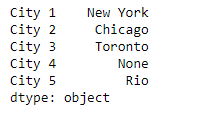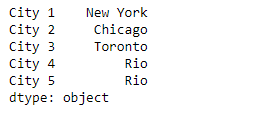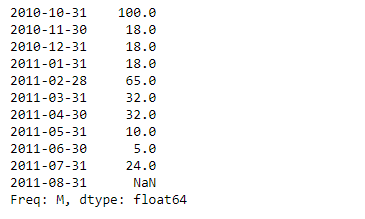Python Pandas Series.bfill()
Pandas系列是一个带有轴标签的一维ndarray。标签不需要是唯一的,但必须是一个可散列的类型。该对象支持基于整数和标签的索引,并提供了大量的方法来执行涉及索引的操作。
Pandas Series.bfill()函数是后向填充方法的同义词。这个函数用来填补给定系列对象中的缺失值。
语法: Series.bfill(axis=None, inplace=False, limit=None, downcast=None)
参数:
axis:axis=1
inplace :对同一对象进行修改。
limit : 最大的连续缺失值填充数量
返回:系列
示例#1:使用Series.bfill()函数来填补给定系列对象中的缺失值。
# importing pandas as pd
import pandas as pd
# Creating the Series
sr = pd.Series(['New York', 'Chicago', 'Toronto', None, 'Rio'])
# Create the Index
index_ = ['City 1', 'City 2', 'City 3', 'City 4', 'City 5']
# set the index
sr.index = index_
# Print the series
print(sr)
输出 :

现在我们将使用Series.bfill()函数来填补给定系列对象中的缺失值。
# fill the missing values using backward fill method
result = sr.bfill()
# Print the result
print(result)
输出 :

正如我们在输出中所看到的,Series.bfill()函数已经使用后向填充方法成功地填充了给定系列对象中的缺失值。
示例#2 :使用Series.bfill()函数来填补给定系列对象中的缺失值。
# importing pandas as pd
import pandas as pd
# Creating the Series
sr = pd.Series([100, None, None, 18, 65, None, 32, 10, 5, 24, None])
# Create the Index
index_ = pd.date_range('2010-10-09', periods = 11, freq ='M')
# set the index
sr.index = index_
# Print the series
print(sr)
输出 :

现在我们将使用Series.bfill()函数来填补给定系列对象中的缺失值。
# fill the missing values using backward fill method
result = sr.bfill()
# Print the result
print(result)
输出 :

正如我们在输出中所看到的,Series.bfill()函数使用后向填充方法成功地填充了给定系列对象中的缺失值。注意最后一个值没有被填充,因为在该元素之后的系列中没有有效的值。
 极客教程
极客教程